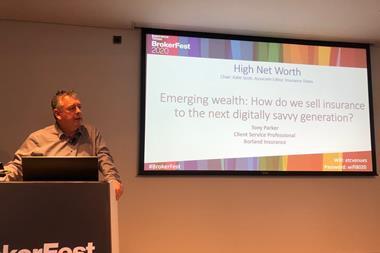Determining insurable gross profit versus an accounting gross profit can be a headache for policyholders, however if calculated incorrectly, the ramifications on business interruption claim payouts could be impactful. Insurance Times explores the issue as well as possible solutions
Insureds are leaving themselves open to underinsurance on their business interruption (BI) policies by confusing what is meant by ‘gross profit’ within insurance policy documentation versus the general accountancy meaning, said Damian Glynn, director and head of financial risks at Sedgwick.
The crux of the matter lies in terminology definitions – while the general accountancy term ‘gross profit’ “has no definition”, said Glynn, the insurance version of gross profit has a very distinct meaning and policy wordings will specifically list “the costs that you knock off your turnover”.
If policyholders calculate their insurable gross profit using general accountancy methodology rather than checking the policy small print, this could lead to underinsurance.

Sareena Bamrah, director at Accuracy, agreed with Glynn’s view. She said: “The difference between insurable gross profit and accounting gross profit are the uninsured working expenses.
“These are the expenses of the business that vary in direct proportion to turnover, which can be defined within the policy. The uninsured working expenses are deducted from revenue to derive the insurable gross profit.
“This is an area of confusion for many policyholders who unintentionally declare an inadequate sum insured.
”Unfortunately, underinsurance is often not realised until a claim occurs which limits the organisations ability to recover the full extent of the financial losses sustained.”
Common confusions
There are a few pitfalls that insureds could succumb to when it comes to confusing gross profit terminology. The first one, according to Glynn, is around purchases.
He explained: “The difficulty with that is some policies say raw material purchases. All insurers assume that purchases mean raw materials.
“The problem is for your businessman, purchases just means things that you buy. So, there’s a box on your VAT return and it will say what is the total value of purchases in the last quarter? Well, purchases for the VAT man includes electricity, it includes buying a new forklift truck. So, we have these terminology problems.”
Cranston Watts, senior manager at Sedgwick, added that employee wages can also prove problematic.
“A policyholder in calculating their rate of gross profit will take the revenue and then they’ll knock off the costs of actually producing what they’re producing and then they’ll knock off the wage costs involved in producing the goods.
”But the insurance policy might say the wages don’t get deducted, it’s only the cost of producing the goods,” he said.
Adding to this, Glynn said: “There is no accountancy definition, there’s no statutory definition of gross profit, and people talk about the difference between the accountancy definition and the insurance definition. There isn’t a difference because there isn’t an accountancy definition at all.
“So commonly, if you’re a manufacturer, you will say all of the wage costs of the production employees, all of the power costs to make my products, as well as buying the raw materials, all of that is my cost of production, so I’m going to knock it all off to get to gross profit.
“If you knock off more costs to get to your accountancy gross profit than the policy says you should, obviously you’ve got a problem because you’re declared number is going to be significantly different to what it should be.

“So, insurance gross profit should be higher.”
Declaration linked policies also enter the underinsurance debate, Glynn continued, adding that around two-thirds of insureds have this type of policy.
“In the absence of an average clause, the insurer – generally speaking – is going to have to pay unless the error is so enormous that the risk described is not the actual risk. If the number is so wrong – if I say to you my gross profit is £10 and it turns out to be £1m, you might say well I wouldn’t have insured it for all sorts of reasons if it £1m. So, the duty of fair presentation is an issue,” he said.
“But there’s another point here and that is if you pay three-quarters of the premium that you should pay because you’ve got your gross profit wrong and you still get paid in full, but I pay the full premium and I get paid in full also, what am I going to make of it as a policyholder if I discover that some people are not putting their due amount into the common pot from which claims are paid?”
Typically, “where a policy is declaration-linked, there’s not [a] proportional reduction to the value of the claim [because there is] no average clause,” Watts explained. “But where average applies, you’ll have a claim and that will be proportionately reduced based on the level of the underinsurance.”
No winners
Sedgwick has backed up its stance on gross profit confusion with research, led by Watts. This included analysing the “the rate of gross profit from the policyholder’s account and what was the rate of gross profit as per the insurance policy” for around 200 claims.
Speaking on the findings, Watts said: “What this has done is highlighted a number of sectors where there is a significant divergence between the rate of gross profit from the insured’s accounts and the rate of gross profit as defined in the insurance policy.
“We’ve identified about seven or eight sectors where there is quite a significant difference between the two rates of gross profit.
“Where there is a significant difference between the insurance rates of gross profit and that for the accounts, that can lead to underinsurance, which is not a great situation at all. It’s a situation where no-one wins.
“The policyholder whose expectations are not met, they’ve bought an insurance policy, they’re not going to get paid as much as they thought they would have.
“It’s difficult for the broker because they potentially have not got the level of cover right and it’s difficult also for the insurers in [that] the policy is ultimately not doing what it’s meant to do, which is to mitigate the loss, to get the business back up and running as quickly and as smoothly as it can. There are no winners from underinsurance.”
Glynn added that a 2017 report from the Chartered Institute of Loss Adjustors found that “45% of people are getting it wrong, the gross profit”.
Broker responsibility
The issue surrounding gross profit terminology gained further notoriety in the 2014 legal case Eurokey Recycling Ltd v Giles Insurance Brokers Ltd, where waste management company Eurokey brought a claim for damages, for negligence and breach of contract, against its insurance broker following a fire at its Leicestershire-based premises in 2010.

According to a report by Brick Court Chambers, when Eurokey attempted to claim for its losses after the fire, “the insurers threatened avoidance and negotiated a settlement with Eurokey on the basis that the latter was significantly underinsured for material damage and business interruption.
“Eurokey alleged that the underinsurance arose from Giles’s negligence, including Giles’s alleged failure adequately to explain how the sum insured for business interruption should have been calculated.”
Although the judge, Mr Justice Blair, dismissed the claim in its entirety, the case’s judgment included a comprehensive list of brokers’ duties pertaining to arranging business interruption (BI) cover.
This included that “the client must be given an adequate explanation of how to calculate the sum insured and choose a maximum indemnity period, and must take reasonable steps to ensure that the client fully understands the meaning of ‘insurable gross profit’.”
Glynn added: “Gross profit, when we use it in terms of a policy, is a technical term. It’s a term of art is the phrase the courts use.
“It just seems to me that taking a term that is in general commercial use and giving it a very specific definition is going to increase the probability that people will get the answer wrong.”
Possible solutions
Perhaps one of the most simple methods of mitigating miscalculations is to amend the terminology – rather than use ‘gross profit’, insurers could use terms such as ‘insurable profit’ or use ‘gross revenue’ as a barometer instead. Although “different terminology won’t solve everything, it will move things quite a bit further forward. I think that would move things forward significantly,” Watts added.
Glynn noted that Aviva, Chubb and QBE have switched to use ‘insurable profit’ in their policy wordings, for example.
However, “there are probably at least 10 insurers who are offering policy cover now on the basis of gross revenue cover” Glynn added, “because it’s simpler. It just avoids misunderstanding”.
“If I say to you what’s your gross profit, but we mean different things by it, you may well be getting it wrong,” Glynn said.
“If I say to you what’s your revenue - if you don’t know what your sales are, you probably shouldn’t be in business, so that maximises the chance that the answer will be right.
“I think within the last 12 to 18 months, we have seen wider adoption of gross revenue cover. I do see a shift. It’s still very much a minority, but a less insignificant minority.”
Watts agreed that “using gross revenue as a measure of cover has huge benefits”.
However, this switch in language could still pose problems for insurers. Glynn explained: “The problem for insurers is that you start at a higher number and if you rate it for premium purposes the same way as gross profit, it’ll just be too expensive. Also, there may be capacity issues in terms of reinsuring in the markets. There isn’t a simple answer to this.”
Watts concurred: “If you ask any businessperson ‘what is your turnover, what is your sales’, they’ll know the answer straightaway. The problem with that is it could just lead to some pricing issues in the market.”
Parametric potential?

Another option, added Glynn, is parametric insurance because it is “utterly black and white. There’s no subjectivity” because it is based on “a measurable trigger”.
Although Glynn doesn’t think this type of insurance could be used for insured’s “main business because the stakeholders would want to make sure that the risk is properly covered”, there is the potential for it to come into play “for lower level claims, so you could do it with flooding, you could do it with footfall for retailers or shopping centres”.
“I’m not saying parametric is the answer per se, but you could say well what we’ll do is we’ll have a parametric cover at the lower level and then a full fat policy for higher amounts,” he added.
But this isn’t a risk-free option – Glynn cites capacity as a potential problem here.
He continued: “I think the difficulty for insurers is capacity and just making sure that they understand what is at risk.
“The benefit of people declaring gross profit or insuring gross profit is that there is a basis for the calculation and therefore it’s possible for the insurer to estimate a maximum probable loss, an estimated maximum loss (EML) and therefore you charge your premium based on that.
“If you were moving to just limits, it would make EMLs very difficult.”
Has the FCA test case impacted the discussion around ‘gross profit’ terminology?
Damian Glynn, director and head of financial risks at Sedgwick, said that although the High Court test case itself will not help the debate around the use of ‘gross profit’ within policy wordings - because it is not dealing with quantum - it will however “help in terms of a general refocus on what business interruption cover is”.
A greater issue, however, is if policyholders are turning to their brokers and asking for ways in which to cut costs by reducing cover because of the detrimental financial impact of the coronavirus pandemic.

“It’s very easy to come up with a lower gross profit figure because you just knock off a load of other costs. The problem is that means that the policy is unlikely to work for you when you try to make a claim,” Glynn explained.
“Because insurance is intangible, people aren’t really understanding what it is they’re buying at the start. You can save money on business interruption - you can insure for inappropriately short periods. You can knock off lots of costs.
“You can say to the insurer ‘I want to uninsure more costs’, increase the list of costs that I take off turnover and what that then means is that the gross profit percentage is lower, so you recover a lower rate in the pound if you have a fire.
“Where people misunderstand is if they have a partial loss. If you burn to the ground, the costs are predictable, but if you have a machine that is only working at 80% capacity, so you need to work through the night as well as the day, most of your costs are going to carry on; in fact they’re going to go up. So, partial loss assumptions are dangerous.
“But I do think that Covid is, in terms of price and people wanting to not pay more than they need to for things, and I’m not criticising that as a motive at all, but you just need to be careful that if there is dead wood, you’re only removing dead wood and you’re not scraping away at the living.”
Hosted by comedian and actor Tom Allen, 34 Gold, 23 Silver and 22 Bronze awards were handed out across an amazing 34 categories recognising brilliance and innovation right across the breadth of UK general insurance.




















































No comments yet